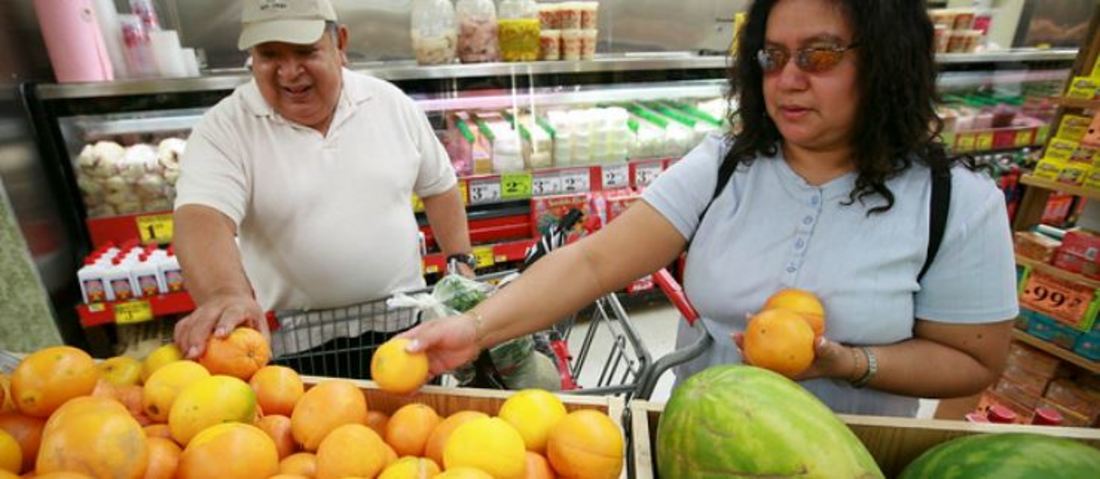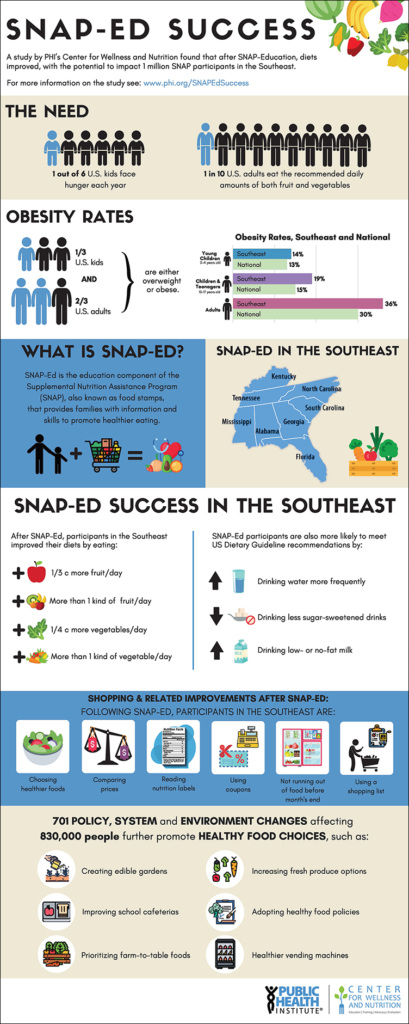
Press Release
Diet, Shopping and Other Nutrition Measures Improved for Low-Income Residents in Southeastern States Following USDA SNAP-Ed Participation
-
Focus Areas
Chronic Disease Prevention, Healthy Communities -
Expertise
Research – Quantitative -
Programs
Center for Wellness and Nutrition

Eight-State Study in the Journal of Nutritional Science Finds Significantly Higher Consumption of Fruits and Vegetables by Low-Income Participants of USDA SNAP-Ed Programs
Oakland, CA-Research by the Public Health Institute’s Center for Wellness and Nutrition (CWN) with colleagues from the University of California Davis and four universities in the Southeast published today in the Journal of Nutritional Science finds that low-income residents of eight Southeast states, where obesity rates are among the highest nationally, consumed significantly greater amounts of fruits and vegetables, and improved several other shopping and nutrition-related behaviors following participation in USDA SNAP-Ed programs.
USDA’s SNAP-Ed programs provide nutrition education and obesity prevention interventions that target vulnerable populations (individuals and families who are at or below 185% of the federal poverty level) across the US. The study, “The US Supplemental Nutrition Assistance Program – Education improves nutrition-related behaviors” reviewed SNAP-Ed data collected in 2017 from participants in 25 different SNAP-Ed implementing agencies in Alabama, Florida, Georgia, Kentucky, Mississippi, North Carolina, South Carolina, and Tennessee – states that make up the Southeast region of the USDA’s Food and Nutrition Service (FNS), which oversees the SNAP-Ed program. The Southeast has the highest average share of residents receiving SNAP benefits at 15.1 percent, with more than 1 million people in the region potentially adopting the positive dietary and nutritional changes found in the study.
The largest quantitative, multi-state study of SNAP-Ed to date and the first to aggregate data from unique SNAP-Ed programs to evaluate outcomes regionally, the CWN study reviewed surveys from more than 43,000 low-income children, adolescents, and adults before and after SNAP-Ed interventions. Following SNAP-Ed, low-income residents in the Southeast were more likely to report consuming more than one kind of fruit and one kind of vegetable per day as well as other  dietary improvements including:
dietary improvements including:
- on average increasing their daily consumption of fruit by about ⅓ cups and of vegetables by nearly ¼ cups
- drinking water more frequently
- reducing consumption of sugar-sweetened beverages, and
- drinking low- or no-fat milk.
Participants also were more likely to:
- choose healthier foods on a budget
- read nutrition labels or ingredient lists
- compare prices before purchasing food
- identify foods on sale or use coupons
- use a list when shopping, and
- not run out of food before month’s end (a measure of food security).
The findings show that following participation in a SNAP-Ed program, participants are statistically significantly more likely to meet the recommendations from the U.S. Dietary Guidelines and to adopt positive food resource management behaviors. In addition to the dietary and nutritional improvements, the study documented 701 policy, systems and environment (PSE) supports cumulatively adopted across the Southeast region that reach about 830,000 people that further promote healthier choices among low income families. Some common PSE changes included creating edible gardens, improving food displays in school cafeterias, prioritizing farm-to-table foods, increasing fresh or local produce options, implementing standards for healthier food policies and adopting school or childcare wellness policies.
“Healthy foods can be expensive, and a SNAP budget is modest. But SNAP-Ed is helping low-income Americans in the Southeast make strategic choices that stretch their food dollars and empower them to choose more fruits and vegetables and other healthy foods,” said Amy DeLisio, the director of the Center for Wellness and Nutrition at the Public Health Institute and a co-author of the study. ”In the long run, these changes can play an important role in reducing their likelihood of diabetes, hypertension and other nutrition-related diseases, and in reducing health care costs across the region.”
In addition to PHI and UC Davis, representatives from all 25 implementing agencies in the Southeast were invited to participate in the study as co-authors, and seven accepted, representing four agencies: the University of Kentucky, University of Tennessee, University of Georgia and Auburn University.
Related Resources
View and download the infographic.
For more information, see the Center for Wellness and Nutrition website.
# # #
About the Public Health Institute
The Public Health Institute, an independent nonprofit organization, is dedicated to promoting health, well-being and quality of life for people throughout California, across the nation and around the world.
More Updates
Work With Us
You change the world. We do the rest. Explore fiscal sponsorship at PHI.
Support Us
Together, we can accelerate our response to public health’s most critical issues.
Find Employment
Begin your career at the Public Health Institute.



